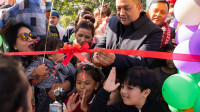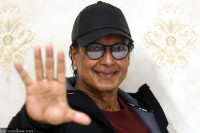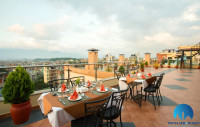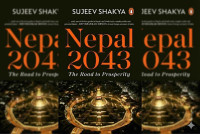Culture & Lifestyle
Why we need to talk about caste
A few people from the art and entertainment community are encouraging conversation around caste and Dalit oppression to break off age-long structural hierarchy that is deeply rooted in society.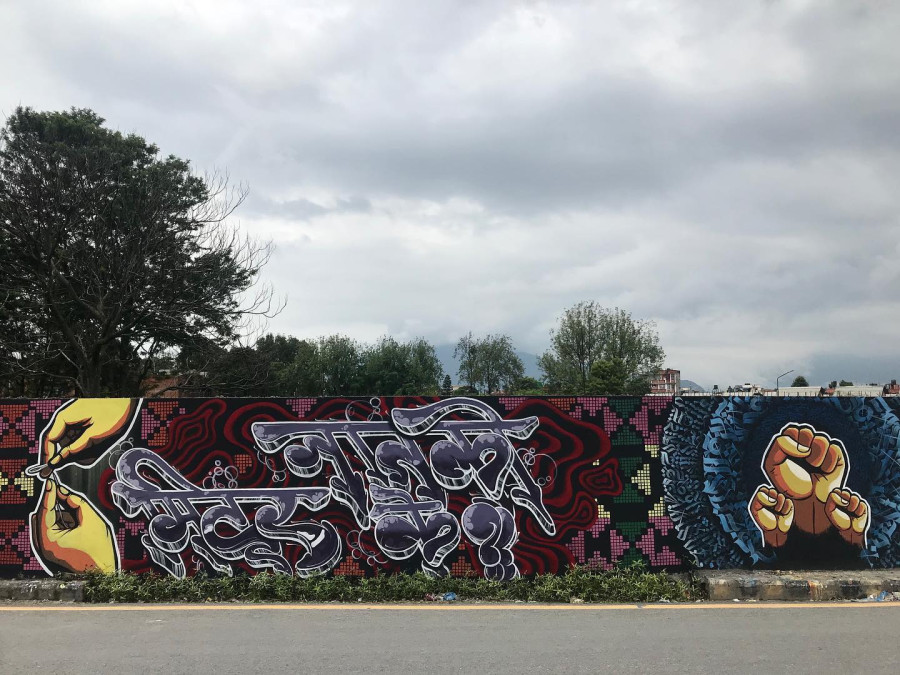
Srizu Bajracharya
Earlier this week, a group of artists, drenched in sweat, painted a series of street art about Dalit resilience on the walls of Lalitpur Engineering College as part of the ‘Paint the Revolution’ project.
One of the murals states: ‘Jaat ko metre ke?’ (What is the measure of caste?). The calligraphy is juxtaposed next to an artwork of a person’s hand trying to thread a needle, as if to say we need to bind the world together or perhaps to suggest the opposite: how deeply our society is ingrained in the caste system.
“It was an important step for me to respond to the recent killing of Dalit people in Rukum,” says 20-year-old Surbhi Darnal, who is one of the artists behind the murals. “The incident was a horrific realisation of how our society is still entrenched in the ills of the caste system,” she says.
The project, titled Paint the Revolution, is part of the Dalit Lives Matter Nepal campaign, organised in collaboration with Kaalo.101, an independent art collective based in Patan.
In the wake of the incident in Soti, Rukum, and in Rupandehi (where a 12-year-old Dalit girl was found dead after being married off to the man who raped her), some from the art and entertainment sector are making attempts to keep the conversation going about caste-based discrimination, particularly about the oppression enforced on Dalits. Many of these people are also working with organisations advocating for the elimination of caste-based discrimination with only one ambition: to make people realise the patterns of prejudices the caste system fosters.
“Art has a wider reach, and I believe it can really communicate the depth of issues to people. It has the power to show different colours of life, and move people with visual representation,” says Bridhika Senchury, campaign lead of Dalit Lives Matter Nepal.
Celebrated actor Rajesh Hamal also returned to the small screen to host a 12-episode talk show titled ‘Jaatko Prashna’, which is produced by Samata Foundation, an NGO that works for the rights of marginalised communities. The documentary-styled programme aspires to take on the layers of age-long discrimination against Dalit and other ethnic minorities in the country through incidences in the past.
In the show’s first episode, Hamal talked to the parents of Ajit Mijar, an 18-year-old who was murdered in 2016 when he married a woman from another caste. The episode attempted to highlight inter-caste marriage intolerance that has repeatedly invoked crimes.
In the show, Hamal carefully helps the viewers understand the aftermath of the incident that caused a family to lose their child, and also reminds them that this is not the first time such a killing has happened. It has now been four years since Mijar’s death, and his parents have taken an oath to not perform his funeral rites until justice is served. And Hamal through his conversation questions why justice has failed Mijar’s family.
“I think right now, it’s important for everyone to talk about caste discrimination. It’s after all conversations that slowly make way for change,” says Hamal in a phone conversation with the Post. “And our attempt with the show is the same, to make people realise caste discrimination and give them a perspective on what our society’s reality is,” he says.
Hamal’s ‘Jaatko Prashna’ has been viewed by more than a hundred thousand people and just as anticipated with his presence, the topic of caste discrimination over the weeks has got a lot of attention.
“When actors like Rajesh Hamal speak on the issue of caste discrimination and Dalit oppression, their persona can influence a lot of people. And we wanted Rajesh Hamal to host the show because he is a household name in the country,” says Pradip Pariyar, the chairman of Samata Foundation.
“Even their small initiative makes a great ripple effect,” says Senchury who is also an associate communication and outreach coordinator at Samata Foundation. According to Senchury and Pariyar, if people from outside the Dalit community raise awareness about caste-based discrimination, their voices can become more significant, as it is they who—advertently or inadvertently—exercise oppression structurally.
“And so we need more creative voices to aware people about Dalit issues because just informing doesn’t really make a change, we need to make way for conversations about caste through every possible way,” says Senchury. “We need artists to speak up through their works and platforms to influence people’s mindset.”
But such initiatives from the art and the entertainment sector haven’t been happening enough and as often as it is supposed to. “When caste-based discrimination stories come to light they spark conversation on social mediam but in daily life, we hardly talk about it; infact, as much as possible, we try to avoid the topic itself,” says Suman Khadka, another artist involved in the ‘Paint the Revolution’ project.
Actor Bipin Karki agrees. “It’s not that we haven’t talked about these issues before, but these conversations have been very limited to an incident, and stories of the Dalit community, except for the atrocities, haven’t really come forward,” he says.
When Karki was just starting out in the Nepali movie industry, he started by playing Dalit characters in movies and theatrical plays. “In the beginning, I played whatever character I got but later in my career, I chose to play Dalit characters, as I understood what I could show through my depiction to the audience,” he says.
But over the years, structural caste oppression has been persisting more invisibly says the artist. Back when Karki was preparing for his Dalit character in the movie Kalo Pothi he spent two months living in a remote part of Mugu as his character ‘Jit Bahadur’. Nobody in the village knew that he was actually an actor just trying to get into character.
“One time, when I tried to enter a chiya pasal of a dai with whom I often used to joke around, he chided me. It took me a while to understand his reaction. I had forgotten that for him I was a Dalit,” says Karki. “That momentary humiliation has always stayed with me, and has made me more aware of the discrimination the Dalits live with,” he says.
Karki then went on to play the role of Baburam, a damai in the movie Prasad. “A lot of people from the Dalit community had thanked me for representing their story on the big screen and I have been grateful that I have played a part in talking about their matters,” he says.
But according to Karki, in recent years, with the awareness of inclusiveness, a sort of duplicity has entered the movie industry where a quota system reserves Dalit representation in movies. “The inclusiveness that we see has not happened yet with acceptance but rather because of requirement. People are just fitting things together to seem inclusive which I think is more deceiving, as it has done nothing to solve the problem but just wrap things up with a face of diversity,” he says.
While conversations of caste privilege and discrimination have been taking place on social media platforms, people need to accept the problem and think of it as their issue for that inclusivity to happen more organically, says Pariyar who has been advocating about Dalit issues for years. “Until and unless we see inclusivity and representation in all sectors, this oppression will continue,” he says.
In recent years, although Dalit issues have been covered by the media, they have reflected more the atrocities the Dalits have faced rather than stories of the Dalit community’s culture, art and work and their diversity. “It’s important that we also talk about their resistance and resilience, and try to empower them with our works,” says a representative of Kaalo.101. “And that is what we made sure we did with the murals, we didn’t want to paint a picture of oppression but rather their work diversity, skills and strength.”
The month of August has seen a lot of attempts by artists to push forward the issues of caste as time challenges to bury the issues of Dalit discrimination, as happened in the past. Musician Jerusha Rai also started a fundraiser for the families of the murdered Dalits with researcher Tashi Tewa. However, the fundraiser, as of yet, has not received much traction. But for many of these artists, their main attempt seems to be to keep reminding people of caste-based issues to ensure the conversation continues—on an individual level as well as in the community.
“If artists like us voice matters of caste it will be easier for people to have conversations around caste with their parents, friends and people in their community. And in doing so they will be more aware of how they are permitting oppression,” says Hamal. “Awareness is the key to change, and that happens only when we talk about these issues more openly and persistently.”




 20.12°C Kathmandu
20.12°C Kathmandu
